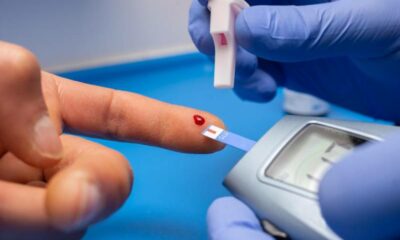Prediabetes, a state often shrouded in mystery, lurks beneath the surface for millions of individuals. It’s a condition where blood sugar levels are higher than normal, yet not high enough to qualify as full-blown diabetes. The silent and insidious nature of prediabetes makes it a public health concern, potentially progressing to type 2 diabetes if left unaddressed. However, this doesn’t have to be a predetermined path. By recognizing the signs, understanding the risk factors, and taking proactive steps, you can reclaim control of your health and prevent the development of diabetes.
Unveiling the Disguise: Symptoms of Prediabetes
Unlike its more vocal counterpart, type 2 diabetes, prediabetes often goes unnoticed. The majority of people with prediabetes experience no outward symptoms. This makes regular checkups and blood sugar screenings crucial for early detection. However, for a small percentage of individuals, prediabetes might unveil itself through subtle clues:
- Increased Thirst and Frequent Urination: Our bodies strive to maintain a healthy blood sugar balance. When blood sugar levels rise, the kidneys work overtime to remove excess sugar through urine. This can lead to increased thirst as the body attempts to replenish lost fluids.
- Blurred Vision: Elevated blood sugar levels can cause temporary fluctuations in the fluids surrounding the lenses in your eyes, affecting their ability to focus properly. This can result in blurry vision, a symptom that usually resolves with improved blood sugar control.
- Unusual Fatigue: Your body relies on sugar for energy. When your cells become resistant to insulin, the hormone responsible for ushering sugar into the cells, they struggle to access the fuel they need. This can lead to fatigue and a general lack of energy.
- Skin Changes: Acanthosis nigricans is a condition characterized by darkened, velvety patches of skin, typically appearing in the armpits, groin, and around the neck. While not exclusive to prediabetes, its presence can be a potential indicator.
- Slow-Healing Wounds: Chronically high blood sugar levels can impair circulation and the body’s natural healing response. This might result in wounds that take longer to heal or are prone to infection.
It’s important to remember that these symptoms can be caused by other underlying conditions. If you experience any of these, consult your doctor for a proper diagnosis.
Beyond Symptoms: Unveiling the Risk Factors
Several factors can increase your risk of developing prediabetes:
- Family History: Having a parent or sibling with type 2 diabetes significantly raises your risk.
- Weight: Being overweight or obese, particularly when excess fat accumulates around the waist, can contribute to insulin resistance.
- Physical Inactivity: Regular exercise improves insulin sensitivity and helps your body manage blood sugar levels more effectively.
- Race/Ethnicity: Certain racial and ethnic groups, including Hispanic/Latino, African American, Asian American, and Native American populations, have a higher risk.
- Gestational Diabetes: Having gestational diabetes, a form of diabetes that develops during pregnancy, increases your risk of developing type 2 diabetes later in life.
- Polycystic Ovary Syndrome (PCOS): This hormonal imbalance can affect insulin sensitivity and increase the risk of prediabetes.
Being aware of your risk factors empowers you to take preventive measures.
Dismantling the Threat: Strategies for Managing Prediabetes
The good news is that prediabetes is not a one-way street to diabetes. With a commitment to healthy lifestyle changes, you can significantly reduce your risk of progression. Here are some key strategies:
- Diet: Focus on a balanced diet rich in fruits, vegetables, whole grains, and lean protein. Limit processed foods, sugary drinks, and unhealthy fats.
- Weight Management: Even modest weight loss, around 5-7% of your body weight, can significantly improve insulin sensitivity.
- Exercise: Aim for at least 150 minutes of moderate-intensity exercise or 75 minutes of vigorous-intensity exercise per week. Physical activity helps your body utilize sugar more effectively.
- Stress Management: Chronic stress can elevate blood sugar levels. Explore stress-reduction techniques like yoga, meditation, or deep breathing exercises.
- Sleep: Prioritize good quality sleep. Aim for 7-8 hours of sleep each night. Studies suggest inadequate sleep can impair insulin sensitivity.
- Smoking Cessation: Smoking damages blood vessels and increases the risk of diabetes complications. Quitting smoking is crucial for overall health.
- Medications: In some cases, your doctor might prescribe medications to help manage blood sugar levels.
Beyond Self-Management: The Role of Your Healthcare Team and Building a Support System
While self-management is crucial, navigating prediabetes doesn’t have to be a solitary journey. Building a strong support system and collaborating with your healthcare team are essential for long-term success.
- Your Doctor: Schedule regular checkups with your doctor to monitor your blood sugar levels and discuss any concerns you might have. They can provide personalized guidance and adjust your management plan as needed.
- Diabetes Educator: A diabetes educator can provide valuable information about prediabetes, healthy lifestyle choices, and self-management techniques.
- Registered Dietitian: A registered dietitian can help you create a personalized meal plan to support your blood sugar control and weight management goals.
- Support Groups: Connecting with others who understand the challenges of prediabetes can be a source of motivation and encouragement. Support groups can be found online or in your community.
- Family and Friends: Enlisting the support of loved ones can be invaluable. Talk to them about your prediabetes and how they can help you stay motivated.
Remember, prediabetes is a wake-up call, an opportunity to invest in your long-term health. By adopting a proactive approach, embracing healthy habits, and working with your healthcare team, you can prevent or delay the onset of type 2 diabetes and live a long and healthy life.

 Diabetology1 week ago
Diabetology1 week ago
 Diabetology1 week ago
Diabetology1 week ago
 Diabetology6 days ago
Diabetology6 days ago
 Diabetology1 week ago
Diabetology1 week ago
 Diabetology6 days ago
Diabetology6 days ago
 Diabetology1 week ago
Diabetology1 week ago
 Diabetology4 days ago
Diabetology4 days ago
 Diabetology4 days ago
Diabetology4 days ago








